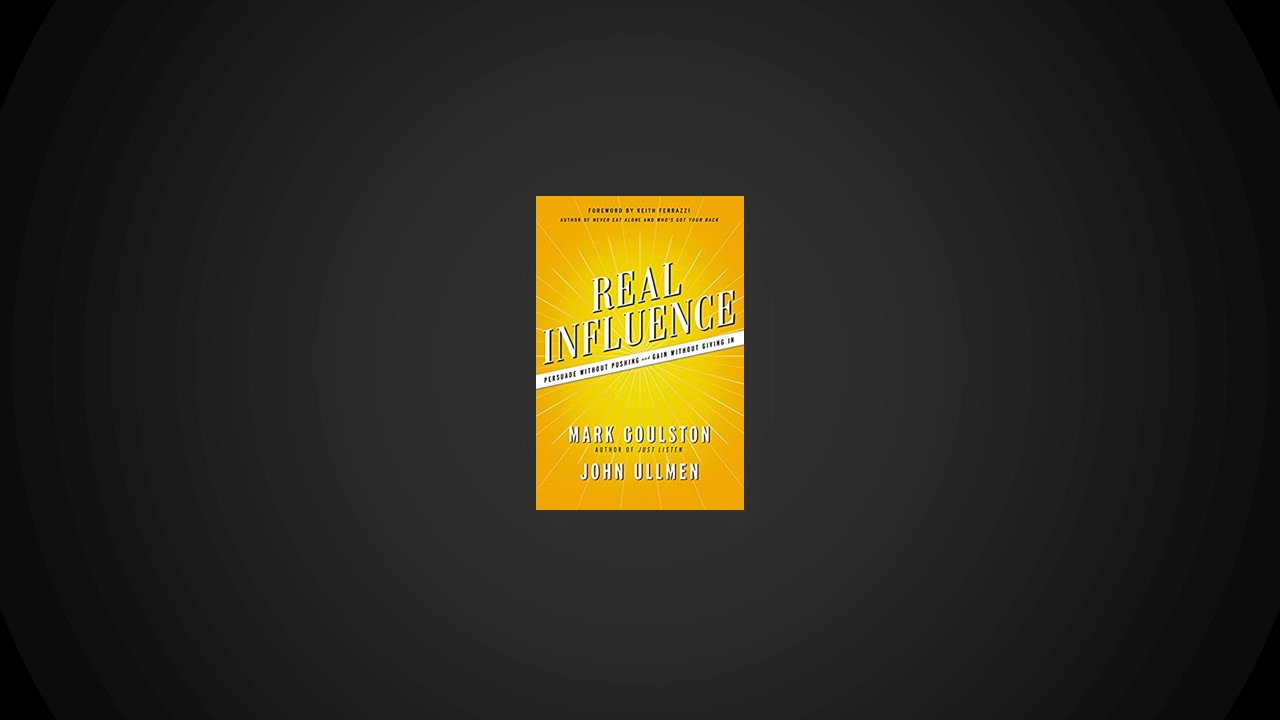This book won’t tell you what you can accomplish by tricking people, manipulating them, or stepping on them. Instead, it will teach you how to be the kind of influencer that you and the people in your life want you to be. That’s because as you build deeper relationships, you’ll drive stronger results. And when you approach relationships by thinking about giving rather than getting, and about adding value before seeking value, you’ll be amazed at the return you see on your investment.
STEP #1 Go for Great Outcomes
To become a master at connected influence, you need to inspire people by going for what’s possible— and then looking beyond that for what still might be possible. And remember that it’s not the size of your goal that makes an outcome great. It’s the ambition to make a difference, the courage to put yourself on the line for a principle, and the willingness to let everyone join in your success. Above all, as you’ll see it’s a determination to focus on the three “R”s of a great outcome: Results, Reputation, and Relationships.
The First “R”: Go for a Great Result
When you take the bold step of going for a great outcome, you’ll get people to think into their futures. You’re not just trying to “trick” them into doing something that’s good for you right now. Instead, you’re showing them a path to a better their there. That’s exciting and inspiring— and it leads to creative solutions, great results, and stronger connections with the people you want to influence.
This doesn’t mean your great outcome needs to be large. It can be as bold as changing the world, or as simple as raising the bar for how you’ll spend the next sixty minutes. It can mean making the most of a conversation, meeting, conference call, presentation, project, or mission. A great outcome doesn’t need to be large in scope, but it needs to be rich in meaning . . . and it needs to be great for everyone involved.
Finding your great outcome can be a challenge— especially if you aim high— but the rewards are astonishing. Here are the stories of two “power influencers” who show how it’s done.
The Second “R”: Go for a Great Reputation
One big reason why disconnected influence is very tempting is because it’s easy. You don’t need to care about the aftereffects of people’s buy-in, because you aren’t planning to stick around to see what happens next. If your actions hurt or disappoint them, you won’t care. And if they need your help, that’s too bad— because you’ll be long gone.
Connected influence, however, requires you to prove that you’re worthy of people’s long-term commitment. To get people to support your great outcomes, you need to support them . . . even when it’s not in your best short-term interest. They need to know that you’re committed to their success as well as yours. And they need to know that if they’re in trouble, you’ll stand up for them, even if the cost is high. In short, you need to be a hero.
A strong reputation will make people want to work with you, want to deal with you, want to listen to you, and want to help you. Because of what they’ve heard and learned about you, they will anticipate that good things will happen, even before they meet you. And, as our three heroes demonstrate, that can turn great outcomes into extraordinary ones.
The Third “R”: Go for Great Relationships
One key message of this book is that even if you begin with few connections and little money, you can become a power influencer. But here’s something else that’s crucial to remember: When you reach the pinnacle of influence, your work in building and strengthening relationships still isn’t done.
All three of these “R”s— results, reputation, relationships— are inescapably interconnected. Over time, and sometimes immediately, the three “R”s catch up with each other. In particular, results achieved by self-serving means will ultimately damage a person’s reputation and relationships. And when that happens, the chance for a great outcome is gone.
This is why the most influential people think about long-term implications even in their short-term actions. They drive for results, but they care about how they get those results. They don’t make trade-offs between getting things done and earning trust and confidence with every interaction. The people around them know that they’re not merely the means to the influencer’s ends, but crucially important ends in their own right.
STEP #2 Listen Past Your Blind Spot
To practice connected influence, you need to break down the barriers that keep you from knowing what other people really think, want, and need.
To Discover Their There, Listen to the Music
Whatever your great outcomes are, you’ll reach them only if you can connect with people. To do that, you need to get out of the blind spot that’s keeping you trapped. The very nature of a blind spot makes it difficult to see what’s blocked by it. But when you can’t see past your blind spot, you can listen past it.
In the sort of listening we’re talking about— we call it listening to learn— there is an energetic, determined humility. Listening to learn implies we don’t know already. It implies there is work to do in order to connect with people on their own terms, with as little distortion as possible from our own biases. It involves not surrendering our judgment, but suspending it.
When we master this type of listening, we draw others in and invite genuine buy-in. Listening with a strong personal motive to learn and understand more leads to real alignment and commitment, rather than creating resistance or the mere appearance of going along. This kind of listening is so potent that, as our next story shows, it can instantly change a relationship— or even change the world.
Over the next month, actively focus on listening to other people with your ears, eyes, heart, and body. For example:
- Listen both to what they say and how they say it— their tone, pace, pitch, volume, variability, and rhythm. Also, in every important conversation you have, ask yourself: What is not being said?
- Observe people’s facial expressions and body language, and notice whether these match the words you’re hearing.
- Listen for people’s moods and emotions. How do they feel about what they’re saying? Why do you think they’re saying it?
- As you’re listening, feel how their words resonate in your own body so you can mirror what they’re experiencing. Ask yourself: What is it like for them? What is it like to be them? Listen to your “gut.” Listen with your “gut.”
- Suspend your judgment before responding. Take time to listen, experience, understand, and try to understand more.
STEP #3 Engage Them in Their There
Once you understand where other people are coming from, it’s time to connect with them in a way that makes them want to support you. To do this, you need to practice the “three gets of engage.” In addition, you need be willing to be provocative, to take some big risks, and to break down barriers in creative ways.
Use the Three Gets of Engage
When you really listen to people, you’ll find out where they’re coming from. And once that happens, you’re ready for the next step in real influence.
By keeping these three “gets” in focus, you’ll be able to shift quickly and effectively from your own perspective to another person’s. Here’s a look at them.
Situational Awareness: You Get “It”
In this get, you show that you understand the opportunities and challenges a person is facing. You grasp the person’s reality in a way that rings true, and you offer ideas that work in the person’s there. When you do this, you’ll hear comments like “You really get it!” or “You really understand what I’m dealing with here.”
Personal Awareness: You Get “Them”
In this get, you show that you understand other people’s strengths, weaknesses, goals, hopes, priorities, needs, limitations, fears, and concerns. In addition, you demonstrate that you’re willing to connect with them on a personal level. When you do this right, you’ll hear people say things like “You really get me!” or “You really understand where I’m coming from on this.”
Solution Awareness: You Get Their Path to Progress
We often speak about the need for leaders to “ enspire” their people. Motivating people pumps them up, but they often deflate back to their usual limiting beliefs and actions after the motivator leaves. Inspiring people lifts them up, but often leaves them not knowing what to do next. Enspiring lifts people up, but also points them toward a great possibility that goes beyond a mere opportunity. When you get people’s path to progress, you help them to reach places they never thought they’d reach.
STEP #4 When You’ve Done Enough . . . Do More
Real influence doesn’t just mean meeting people’s expectations. It means going so far beyond them that you make yourself unforgettable. It means adding value before, during, and after an interaction, and doing more in all three crucial value channels. And it means going beyond adding value yourself, and seeking creative ways for other people to join in great outcomes.
Do More Before, During, and After
When you practice disconnected influence, you go into a relationship knowing exactly what you plan to do. Your goal is to transact a deal— I get this, you get that— and then be on your way.
But real influence doesn’t work that way. To connect in a way that makes you unforgettable, you need to do more. In fact, you need to do a lot more.
To understand why, think back to the last time you helped someone very important in your life achieve a goal. Maybe you helped a friend with a business venture, participated in planning a wedding, or pitched in when a son or daughter moved to a new city.
When you offered your help, it’s a good bet you didn’t say, “I’ll be there to help you from 10 AM to noon— but no longer.” Or “I’ll pack some boxes, but don’t expect me to do anything else.” Instead, you spent hours running errands, hanging decorations, or moving furniture. You volunteered for messy, dirty, or difficult chores like cleaning the fridge or transporting the wedding cake. You did it all for free, and you didn’t resent a minute of it. And then you looked for more things you could do to help.
Why? Because you automatically do more for the people you care about deeply. In fact, you usually don’t even stop to think about it. It comes naturally to you because your relationships with these people matter and you want to strengthen them.
Of course, these relationships are special in your life. They mean more to you than a business connection or a relationship with a casual friend.
But in any relationship, you can go beyond what’s expected. When you do this, you make a statement about who you are as a person and a professional.
Ask Other People To Do More
Make a list of the great outcomes you’re involved in now and the ones you’re planning. For each outcome, identify at least five people who may be able to do more to make the project a success. Focus in particular on people who may be able to bring a very different perspective to your problems and goals.


